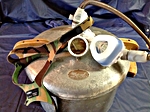(viewtopic.php?f=1&t=156889&st=0&sk=t&sd=a&start=30)
I have concluded regular CPAP sucks for me and probably increases my AHI. I want a bilevel machine. I need help understanding the difference between these three ResMed units so I know what to ask for when I go see my doctor. I have 8 questions:
1) What exactly does Auto mean? Am I right that my inputs are a min EPAP, a max IPAP, and a PS? Then the objective of the algorithm is to use the lowest EPAP pressure possible which will keep the airway open on the exhale? And then the PS (Pressure Support) setting will give me an IPAP pressure of EPAP+PS=IPAP, so long as this sum is lower than the set IPAP maximum? Is that right? Nowhere is this clearly answered. This is my best guess.
2) The S unit says the required settings are two pressure levels and a “spontaneous rate”. What is “spontaneous rate”? I thought S just means it detects my inhales and outbreaths automatically?
3) What is S/T? I understand S is for spontaneous (detects my breaths). And I understand T is for time. This T is also called “backup rate”. Is that correct? The backup rate is the minimum number of breaths per minute the machine will force me to have. Right? And how does it enforce this? Like if I am not on pace to make it, will it start changing from EPAP to IPAP (and vice versa) in advance of what would happen had it waited for a spontaneous breath? I can see how that would help central apneas (which I understand to mean taking an exhale, and then just failing to take the next inhale for no obvious reason). Is this right?
4) All of these units seem to allow an EPAP as low as 3cm, which I strongly want, as discussed in the other thread. It seems the VAuto units however, when in auto mode, only allows 4cm minimum. But I don’t trust the documentation, as it seems to have discrepancies. Can anyone who owns one of these ResMed units confirm the lowest allowable EPAP setting? This is an important consideration to me.
5) Documentation I found for the S/T unit says,
Wait...what??? This has an “VAuto” mode? What is that? How is this different than the AirCurve VAuto? Seriously frustrating. Is this a typo on their part maybe?The AirCurve 10 S/T has a total of five operational modes - spontaneous (S), spontaneous/timed (S/T), timed (T), VAuto and conventional CPAP mode.
6) The S/T unit has iVAPS algorithm, which (if I understand correctly) ensures a minimum volume of air is inhaled into the lungs with each breath. Is this right? If so, how does it do this? Perhaps it detects when my inhale is slowing down, and then forecasts that I am not going to reach the target volume, and then increases the IPAP?
And does iVAPS potentially fulfill the purpose of APAP? APAP ought to ensure that at least some air is being breathed in with each and every breath, right? It seems iVAPS would do that as well, plus furthermore guarantee the air would meet a minimum volume? Seems like there is similarity here? This would make the S/T a very versatile unit that could account for things like different pressure needs according to sleep position? Here is an example of a study with a ResMed unit that uses iVAPS:
http://onlinelibrary.wiley.com/doi/10.1 ... A4F.f04t01
7) What does “TiControl” do? This appears to be a feature on all three units. This means that the S/T unit seems to have both T (backup rate) and Ti settings simultaneously. The documentation contradicts itself. Here are some conflicting quotes from a VAuto unit sales page:
ANDThe TiControl feature on the AirCurve VAuto machine monitors the pattern of inhalation and exhalation, comparing it against the TiMax and TiMin settings on the machine. Those with respiratory disorders such as COPD or obstructive lung disease may experience early or delayed changes from inspiration to expiration, referred to as cycling. The 10 VAuto BiLevel TiControl feature is designed to prevent cycling by setting a minimum and maximum time limit on inspiration. When the machine detects the user breathing which falls outside the machine settings, it will intervene to alter the timing of the delivered IPAP (inhalation) or EPAP (exhalation) pressure.
Wait...what? Did you catch that? The first quote is saying these Ti parameters are checked against only the inhalation duration. But the second quote suggests the Ti parameters are checked against BOTH inhalation AND exhalation durations. Also, the second quote suggests that if your inhalation is too short, it will begin the EPAP pressure. But that wouldn’t help lengthen a short breath! So confusing.The machine is designed to monitor for instances of the inhalation time being too short or too long and compare it against the TiControl settings of the machine. The TiControl feature CANNOT be turned off when the machine is set in VAuto or S mode. TiControl can be turned off when the machine is in CPAP mode.
When the machine detects a breathing pattern which is outside of the setting parameters it responses in one of two ways:
1. If the user attempts to inhale for longer or shorter than the settings the machine will intervene by beginning the set EPAP (expiration) pressure.
2. If the user attempts to exhale for a longer or shorter time than the settings of the machine, it will intervene and begin, or deny, the IPAP (inspiration) pressure until it is called for by the settings.
8 ) The S unit has a Rise Time feature. I read that Rise Time is the time it takes to ramp up to the full IPAP pressure, once you start an inhale. So Rise Time should always be set to be less than TiMax. And Rise Time can only be used if Easy-Breathe is off. Easy-Breathe affects the waveform at both the start of exhalation and inhalation. Rise Time apparently only affects the waveform at the start of inhalation. I guess Rise Time screws your comfort at the start of the exhale then, since Easy-Breathe is disabled? Anyone know?
Apparently the S/T unit doesn’t have a Rise Time setting? Not that I could find anyway. I guess it would conflict with the T algorithm?













